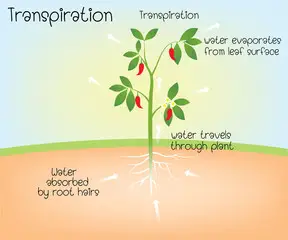Transpiration is the loss of water from the plant surface into the atmosphere. The factors affecting the transpiration include
- Light
- Temperature
- Wind velocity
- Atmospheric humidity
- Atmospheric pressure
- Available water
- Leaf area
- Leaf structure
- Stomatal frequency
- Root-shoot ratio.
Light: Light induces photosynthesis in guard cells leading to sugar synthesis. The osmotic potential increases and the guard cells get turgid. The stoma opens and transpiration occurs. So light indirectly induces transpiration.
Temperature: The rate of transpiration increases with increase in temperature. Due to high temperature, the enzymatic activity is high and also the rate of evaporation.
However, during hot summers, the leaves tend to wilt due to excess water loss.
Wind velocity: The higher the wind, the greater the transpiration. Due to high winds, the water molecules from the surface of the leaves is removed faster leading to vapor pressure gradient inside and outside the leaves. So, the transpiration is high.
Atmospheric humidity: Increase in relative humidity decreases the rate of transpiration. The rate of transpiration will be high in dry air and less in moist air. Also, the water molecules diffuse out slowly in humid weather.
Available water: The higher the water availability in the soil, greater is transpiration. When there is water deficiency, the guard cells become flaccid and the stomata closes. This leads to decrease in transpiration.
All the above factors are external factors related to the environment. But even internal factors affect the rate of transpiration.
Internal factors:
7. Leaf area: The plants with broad leaves have high rate of transpiration. This is because the surface area is high allowing for larger escape of water molecules from the surface.
8. Stomatal number: The number of stomata directly affect the rate of transpiration. The more the number of stomata per unit area of leaf, the greater is the transpiration.
9. Leaf structure: The leaves with surface stomata, thin cuticle have high rate of transpiration. Whereas the desert plants with thick cuticle and sunken stomata have low rate of transpiration.
10. Root shoot ratio: Transpiration increases with root shoot ratio. This is the ratio of the surface of root system to that of shoot system. If the root system cannot absorb sufficient water, there leads to water deficit and decrease in rate of transpiration.